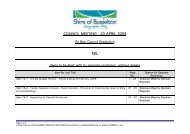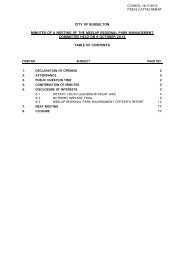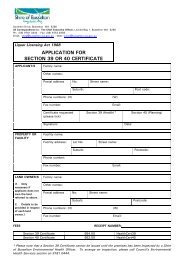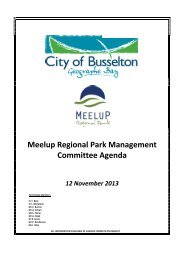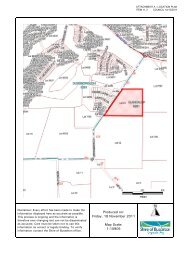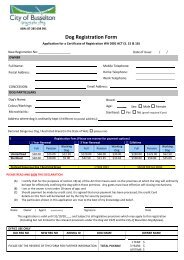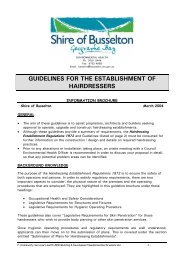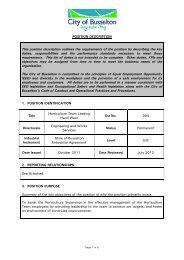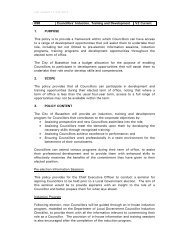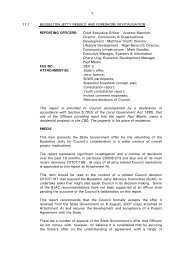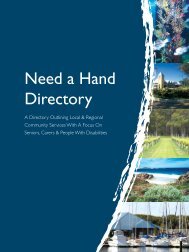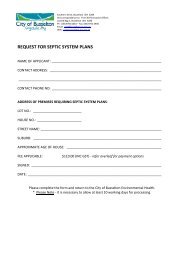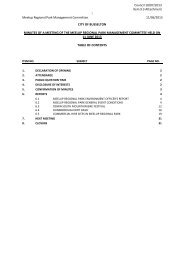Attachments 11.4 and 11.5 - City of Busselton
Attachments 11.4 and 11.5 - City of Busselton
Attachments 11.4 and 11.5 - City of Busselton
You also want an ePaper? Increase the reach of your titles
YUMPU automatically turns print PDFs into web optimized ePapers that Google loves.
ATTACHMENT C - TREATMENT OPTIONS CONSIDERED IN THE COUNCILLOR WORKSHOP OF MAY 2011<br />
ITEM <strong>11.4</strong> COUNCIL 12/10/2011<br />
6<br />
River Bank Re-instatement<br />
This option, as detailed on the plan in attachment B, proposes reshaping <strong>and</strong><br />
revegetating the last remaining section <strong>of</strong> riverbank on the northern side <strong>of</strong><br />
the river along Peel Terrace.<br />
The Council <strong>of</strong> the day held <strong>of</strong>f doing this section as there was some<br />
objection to the replanting that was being done along the banks because <strong>of</strong><br />
the perceived loss <strong>of</strong> views <strong>of</strong> the water. While some sections have been<br />
densely planted (these areas provide good habitat for waterbirds <strong>and</strong> aquatic<br />
fauna) there are others that were planted with rushes <strong>and</strong> sedges <strong>and</strong> these<br />
do not block the views <strong>of</strong> the water. There is now less objection (anecdotal)<br />
to the idea <strong>of</strong> planting the remaining section <strong>of</strong> riverbank. The Geographe<br />
catchment council has discussed the proposal to complete this final section<br />
<strong>and</strong> were generally supportive <strong>of</strong> the design proposed.<br />
The design arose from the issue <strong>of</strong> undercutting <strong>of</strong> the bank at the eastern<br />
end near the railway bridge. It was suspected that exposure <strong>of</strong> ASS caused<br />
slumping <strong>of</strong> the soil structure <strong>and</strong> subsequent erosion.<br />
The solution proposed is to pack the undercut section with a blend <strong>of</strong><br />
organic matter <strong>and</strong> limestone (to neutralise any subsequent effects <strong>of</strong><br />
acidification), <strong>and</strong> place fill along the edge <strong>of</strong> the bank to get a more stable<br />
batter <strong>of</strong> soil to plant into <strong>and</strong> create beach access points. The design<br />
addresses the undercutting problem, provides a natural edge to the river,<br />
<strong>and</strong> provides vistas <strong>of</strong> the water body.<br />
This project will not solve the WQ issues <strong>of</strong> the river but completes the<br />
objective to get a natural edge to the river <strong>and</strong> will make this section <strong>of</strong> the<br />
river much more presentable. The project needs to be properly costed <strong>and</strong><br />
funding sought to assist the Shire to carry out this project. Aboriginal<br />
consultation has been done but approval (bed <strong>and</strong> Banks) will be required<br />
from the Department <strong>of</strong> Water.<br />
Sewerage in-fill<br />
This is not a treatment option so much as a prevention strategy which helps<br />
to reduce the amount <strong>of</strong> nutrients getting into the water body. This<br />
recommendation was made strongly at the beginning <strong>of</strong> the workshop by<br />
the Department <strong>of</strong> Water staff present. The point was made that there is<br />
enough nutrient coming from any one <strong>of</strong> the current sources <strong>of</strong> nutrient<br />
(surface run-<strong>of</strong>f, groundwater <strong>and</strong> sediments) to produce algal blooms in the<br />
river <strong>and</strong> that the longer term solution is to cut <strong>of</strong>f the nutrient inputs from<br />
all sources.<br />
Nutrient levels in groundwater around the Lower Vasse River are largely<br />
attributable to the use <strong>of</strong> septic systems <strong>and</strong> leach drains in the light<br />
industrial area where the groundwater levels are very high in winter. The<br />
systems are <strong>of</strong>ten submerged in groundwater in winter whereas they should<br />
be 1.2m above the watertable to work properly. The preferred solution



